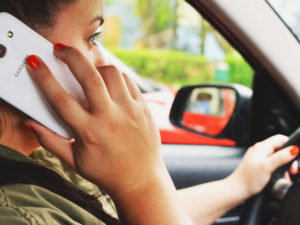Handheld phone use at the wheel rises as penalty impact fades
The number of drivers admitting to using hand-held phones at the wheel is rising again, with younger working-age drivers and those in London the worst offenders.
The research for the RAC Report on Motoring found that although the proportion of drivers admitting to using a handheld phone while driving in 2017 had fallen to 24% on the back of the introduction of tougher penalties, it rose in 2018 to 25%. More crucially, the research also revealed dramatic rises in the proportion of younger working-age drivers admitting to using a phone illegally in 2018.
Drivers in the 25 to 34 and 35 to 44 age groups admitted to a range of dangerous activities involving a handheld phone, with nearly half in the younger age group (47%) saying they make or receive calls while driving – up 7% on 2017, and compared to just 25% of drivers in all age groups.
This rose to a huge 57% among drivers who say they do this while stationary but with the engine running. It is a similar picture among those aged 35 to 44, with 39% admitting to making or receiving calls while driving, and 54% saying they do so while stationary.
And, it is not just phone calls that are the problem – more than a third of drivers aged 25 to 34 (36%) send texts, social media posts or emails while driving, compared to just 16% of drivers in all age groups. A total of 29% of drivers in the 35-44 age group admit to doing this while driving, up a huge 10% on 2017 and back to the same level as in 2016.
Meanwhile almost a third of drivers aged 25 to 34 (30%) said they use a phone to take photos, selfies or videos while driving, which is more than double the proportion of all drivers who do this (16%). A quarter of those aged 35 to 44 (26%) also admit to doing this, up a huge 10% on 2017 and 2016, with more than a third (36%) admitting to doing so while stationary, up from 22% in 2017.
Among all drivers there are also significant increases in the percentage who say they use a handheld phone when they are in control of a vehicle, but not moving – such as when they are at traffic lights or sat in congestion. A huge four-in-10 (40%) admit to checking social media messages, texts or emails while stationary – up from 38% last year – while a third (33%) say they send and post such messages, up from 29% in 2017. More than a fifth (22%) meanwhile record videos or take photos while stationary, up from 16% last year.
Looking at use at a regional level, while many parts of the UK recorded a reduction in drivers admitting to using a handheld phone illegally, London stands out as clearly bucking this trend. A majority in the capital (52%) say they make or take calls using a handheld phone while driving, a figure which is up 16% from 2017 and is higher than in 2016 (47%).
RAC road safety spokesperson Pete Williams said: “While the introduction of tougher penalties for handheld phone use at the wheel was absolutely the right thing to do, we fear any benefits have run their course with this data showing illegal use is now rocketing among some groups of drivers.
“Following the introduction of stronger penalties in 2017, we saw a promising shift with some drivers changing their behaviour for the better and becoming compliant with the law – indeed recent observational data suggested this was the case. Sadly, that didn’t signal the start of a longer-term trend with drivers now seemingly returning to their old ways and putting themselves and millions of other road users at risk.
“While we believe our data provides valuable evidence to policymakers and road safety professionals about where the issues with compliance with the law perhaps lie, we also need much more data about the extent of the problem which it appears is really no less commonplace now than it was in 2016.
“We also know the offence of using a handheld phone is difficult for police officers to enforce, and with police resources as tight as ever the unfortunate reality is likely to be many instances where drivers are getting away with this dangerous act. This is why we believe new forms of detection and enforcement technology could have a valuable role to play here.”













